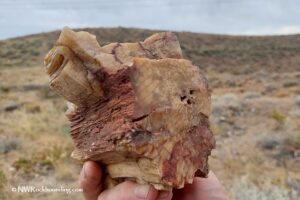
Petrified wood, sometimes referred to as fossilized wood, is a piece of an ancient tree that has become a three-dimensional fossil. The term “petrified” comes from Greek word “petra”, meaning “stone-like”.
This transformation takes place through a process called permineralization, where minerals such as quartz replace the organic material in the wood, retaining its structure and intricate details like bark, rings, and veins.
The petrification process can take anywhere from hundreds to thousands of years. Petrified wood found in the Pacific Northwest is generally between 200 and 400 million years old, and it often comes from tree species such as ancient palm, walnut, myrtlewood, sycamore, and birch.
Petrified Wood Formation
Petrified wood forms when tree trunks or branches are buried in mineral-rich sediment, often alongside volcanic ash. The lack of oxygen halts decay, and over time, water infused with minerals such as silica (quartz), calcite, pyrite, or opal permeates the wood’s structure. These minerals replace the organic matter, turning the wood into stone while preserving its original appearance.
Limb Cast Formation
Limb cast is a specific type of petrified wood that occur when the original wood decays, leaving an empty space later filled with minerals like chalcedony. While these casts don't preserve fine details like the wood’s interior rings, surface features like bark patterns or knots are often visible.

Identification of Petrified Wood
Larger pieces of petrified wood are easier to identify due to the preserved shape and fine details like visible annual rings and bark-like surfaces. Smaller pieces can be more challenging to recognize, and limb casts may be confused with other minerals like agates, which tend to have more rounded shapes.
Petrified Wood Color
The color of the petrified wood depends on the material it has absorbed. Chromium, cobalt, copper, and iron produces green and blue hues.
Oxidized iron and manganese are responsible for yellow, orange, pink, red, and brown shades. Carbon and manganese make black and brown colors.
Opalized wood can display a range of colors, from white and gray to yellow and red, and sometimes even shows iridescent multicolored "fire."

Where Petrified Wood is Found?
Petrified wood is found in various locations across the United States, particularly in the western states like Arizona, Oregon, Utah, Washington, and Wyoming.
Famous Petrified Forests
A petrified forest is an area where large quantities of petrified wood are found. Collecting within the petrified forest or park boundaries is strictly prohibited.
Petrified Forest National Park, Arizona: Famous for its colorful petrified wood, dating back over 200 million years to the Late Triassic period. Note that collecting within the park is illegal, but collecting is allowed on nearby BLM (Bureau of Land Management) land, according to current regulations.
Ginkgo Petrified Forest, Washington: Known for a large variety of petrified wood species.
The Petrified Forest in Calistoga, California: These ancient trees were fossilized by a volcanic eruption that occurred over 3 million years ago.
Escalante Petrified Forest State Park, Utah: This scenic park is known for its vibrantly colored petrified wood.

North American Locations to Collect Petrified Wood and Limb Casts
Petrified wood, while abundant in some areas, can also be found in coastal regions, lake shorelines, riverbeds, and desert environments.
Oregon is known for many locations where you can legally collect petrified wood for personal use.
Hampton Butte is a well-known rockhounding area for its unique green petrified wood, located near the community of Brothers.
Bear Creek is designated by the Bureau of Land Management as a recreational rockhounding area in Central Oregon.
Dendrite Butte and Congleton Hollow, both located about 60 miles from Prineville near Paulina, are popular spots for finding great specimens of limb casts and petrified wood.
The state of Washington boasts the most famous site in the U.S., Ginkgo Petrified Forest, which features a large variety of petrified wood species. While collecting petrified wood within the park boundaries is strictly prohibited, the popular spot to collect petrified wood, Saddle Mountains, is located 36 miles away.
Spectacular opalized wood van be found in Virgin Valley (Nevada) and Fremont-Winema National Forest(Oregon).
Arizona, Nevada, Utah, and Wyoming have excellent collecting sites, most of which are located in deserts.
Reference:
You May Also Like




